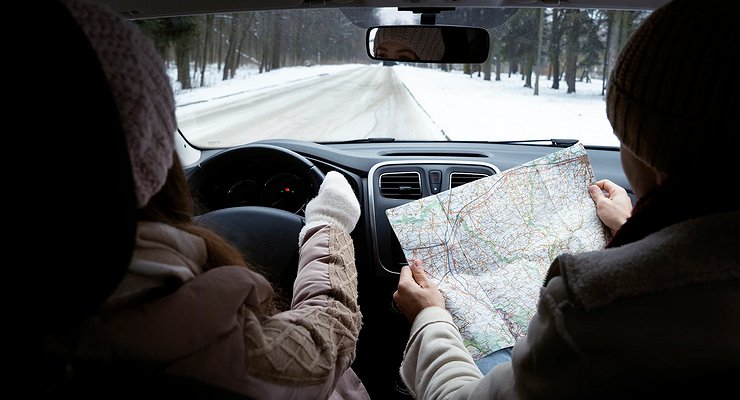Why even a not too strong wind can lead to an accident
- December 20, 2022
- 0
The time of winter holidays is approaching, and that means road trips. A car loaded with stuff and passengers doesn’t always behave the way you’re used to. But
The time of winter holidays is approaching, and that means road trips. A car loaded with stuff and passengers doesn’t always behave the way you’re used to. But

Because the aerodynamics of modern cars have been brought to near perfection, we hardly ever think about how they react to the wind. And how much airflow can affect the behavior of our mechanical pet. And while when we get into a gust of wind we feel some trouble, we usually don’t think about how deadly they can affect our safety. Naturally, the body shape is optimized for head-on interaction with our planet’s atmosphere. And the geometric features have been chosen to not only reduce drag, but also maintain the necessary downforce when moving forward.
However, the airflow does not always blow into the face. And when we go outside, we can face a strong crosswind. The influence of which is very large in winter and not always predictable. And all due to the fact that ice often turns out to be under the wheels, and they hold weakly to the road. Therefore, every motorist is simply obliged to know that the car has a center of gravity. And depending on where it is, the same crosswind can cause completely different effects. Portal “AvtoVzglyad” tells what is common between a sail and a car.
When it comes to crosswinds, we have to consider the shape of the side section of the car. It depends on two factors, the first of which is body type. There are sedans, coupes, convertibles, fastbacks, wagons, hatchbacks, SUVs, minibuses and so on. In some body styles, most of the cross-section is shifted to the rear (SUVs and station wagons). And in sedans and minibuses it is more or less evenly distributed. But not only this is important.
Of great importance is how the surface of the side section is distributed in relation to the machine’s center of gravity. If we talk about passenger cars, then with front-wheel drive, the center of gravity is shifted to the front axle. Full – closer to the center of the distance between the axles. And at the rear, the center of gravity has shifted back. So when we’re exposed to crosswinds, we start to get interested in the ratio of the body’s lateral cross-section in front of the center of mass and behind it.
For example, if the wind is blowing from the right, the rear axle of a front-wheel drive station wagon will try to turn the car to the right. That is, in the direction from which the wind is blowing. And you need to restore the original direction of movement by turning the steering wheel to the left. If there is a rear-wheel drive sedan in such a situation, the wind will turn it to the left. And you have to turn the steering wheel to the right. In addition, the high center of gravity also causes a capsize moment. And if it has no special effect on directional stability, it can have a major impact on handling and safety when driving a car in a curve. Especially if you went on a trip and put a luggage box on the roof.
For example, with the right wind direction in the right turn, extra unloading of the right wheels starts to take place. As a result, it is easy to tip over even when they hit small bumps. So it is necessary to reduce the moments of inertia of the body. And for this you need to slow down. The same applies to the load placed in the cab, as it can change the position of the center of gravity, resulting in a different handling. So if you are going on a long journey, remember that even the wind can have a major impact on your safety. And you need to understand how.

Because the aerodynamics of modern cars have been brought to near perfection, we hardly ever think about how they react to the wind. And how much airflow can affect the behavior of our mechanical pet. And while when we get into a gust of wind we feel some trouble, we usually don’t think about how deadly they can affect our safety. Naturally, the body shape is optimized for head-on interaction with our planet’s atmosphere. And the geometric features have been selected to not only reduce drag, but also maintain the necessary downforce when moving forward.
However, the airflow does not always blow into the face. And when we go outside, we can face a strong crosswind. The influence of which is very large in winter and not always predictable. And all due to the fact that ice often turns out to be under the wheels, and they hold weakly to the road. Therefore, every motorist is simply obliged to know that the car has a center of gravity. And depending on where it is, the same crosswind can cause completely different effects. Portal “AvtoVzglyad” tells what is common between a sail and a car.
When it comes to crosswinds, we have to consider the shape of the side section of the car. It depends on two factors, the first of which is body type. There are sedans, coupes, convertibles, fastbacks, wagons, hatchbacks, SUVs, minibuses and so on. In some body styles, most of the cross-section is shifted to the rear (SUVs and station wagons). And in sedans and minibuses it is more or less evenly distributed. But not only this is important.
Of great importance is how the surface of the side section is distributed in relation to the machine’s center of gravity. If we talk about passenger cars, then with front-wheel drive, the center of gravity is shifted to the front axle. Full – closer to the center of the distance between the axles. And at the rear, the center of gravity has shifted back. So when we’re exposed to crosswinds, we start to get interested in the ratio of the body’s lateral cross-section in front of the center of mass and behind it.
For example, if the wind is blowing from the right, the rear axle of a front-wheel drive station wagon will try to turn the car to the right. That is, in the direction from which the wind is blowing. And you need to restore the original direction of movement by turning the steering wheel to the left. If there is a rear-wheel drive sedan in such a situation, the wind will turn it to the left. And you have to turn the steering wheel to the right. In addition, the high center of gravity also causes a capsize moment. And if it has no special effect on directional stability, it can have a major impact on handling and safety when driving a car in a curve. Especially if you went on a trip and put a luggage box on the roof.
For example, with the right wind direction in the right turn, extra unloading of the right wheels starts to take place. As a result, it is easy to tip over even when they hit small bumps. So it is necessary to reduce the moments of inertia of the body. And for this you need to slow down. The same applies to the load placed in the cab, as it can change the position of the center of gravity, resulting in a different handling. So if you are going on a long journey, remember that even the wind can have a major impact on your safety. And you need to understand how.
Source: Avto Vzglyad
Donald Salinas is an experienced automobile journalist and writer for Div Bracket. He brings his readers the latest news and developments from the world of automobiles, offering a unique and knowledgeable perspective on the latest trends and innovations in the automotive industry.